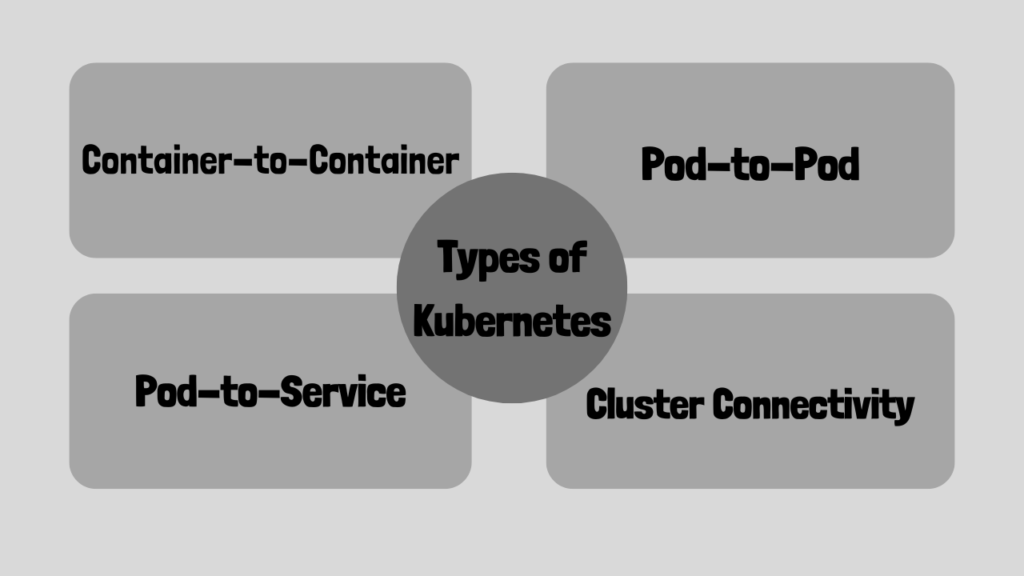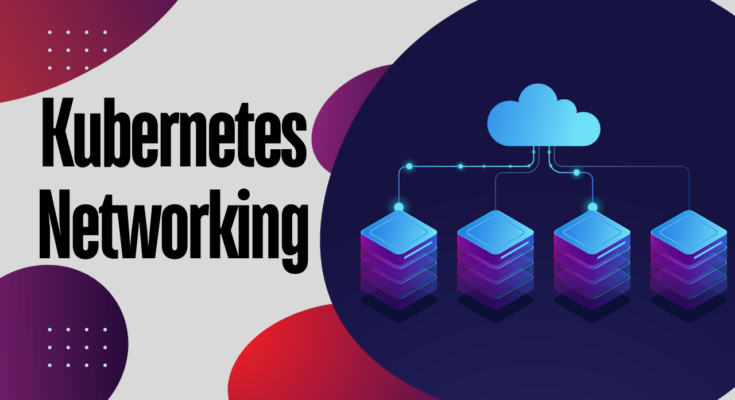Types of Kubernetes Networking, Understanding the Fundamentals and Different Models

Modern cloud-native designs are built around the open-source container orchestration technology Kubernetes, Kubernetes’s networking capabilities are its core; they allow different components in a cluster to communicate with each other seamlessly. We’ll go into great detail on Kubernetes networking in this article, going over its core ideas and the four main networking architectures.
What is Kubernetes Networking?
The systems and procedures used to enable communication between containers, pods, and services inside a Kubernetes cluster are referred to as “Kubernetes networking.” By guaranteeing connectivity and dependability throughout the cluster, it offers the framework for installing and scaling containerized programs.
The 4 Types of Kubernetes Networking Models:

The four different types of Kubernetes networking are as follows:
- Kubernetes Container-to-Container Networking Model: Within the same pod, separate containers can communicate directly with one another using the container-to-container networking architecture. A pod’s containers can connect with one another over the localhost interface since they are all using the same network namespace. When tightly coupled containers need to interact effectively without incurring network cost, this architecture is perfect.
- Pod-to-Pod Networking in Kubernetes: Pod-to-Pod Networking in Kubernetes: Pod-to-pod networking allows pods running on different nodes inside the Kubernetes cluster to communicate with one another. Each pod is assigned a unique IP address, and Kubernetes ensures that pods can route traffic and communicate regardless of their physical locations. Building distributed applications that require components to be spread across numerous nodes for scalability and robustness requires the use of this architecture.
- Pod-to-Service Networking Model: By providing services to pods via a reliable DNS name and IP address, Kubernetes isolates the underlying network infrastructure in the pod-to-service networking paradigm. Services play the role of an abstraction layer, allowing pods to dynamically find and connect with one another. This paradigm makes load balancing and service discovery easier, enabling applications to grow horizontally without human assistance.
- Kubernetes Services for Cluster Connectivity: By offering a reliable endpoint for accessing applications running within the cluster, Kubernetes services are essential in enabling cluster-wide connectivity. The intended accessibility will determine whether services are exposed inside or externally. Services provide smooth communication between applications and external customers by hiding the underlying network specifics, improving the cluster’s overall resilience and dependability.
Choosing the Right Networking Model for Your Kubernetes Cluster
Among the different Kubernetes networking models, choosing the right one for your cluster will depend on a number of variables, such as performance needs, security concerns, and pre-existing infrastructure. To guarantee the best performance and scalability for your applications, carefully consider the features and trade-offs of each networking paradigm.
Tools for Kubernetes networking:

Kubernetes cluster networking management can be accomplished with a variety of tools, each with a unique set of features and functionalities. The following are a few well-liked Kubernetes networking tools:
- Calico: For Kubernetes clusters, Calico is an open-source networking and network security solution. Using common Kubernetes resources, it offers scalable networking and network policy enforcement. Many deployment options, such as overlay, BGP peering, and direct routing, are supported by Calico.
- Flannel: Flannel is a straightforward and user-friendly Kubernetes networking solution. It offers a thin overlay network that enables communication between pods over the cluster’s various nodes. Several backend choices are supported by Flannel, such as host-gateway, AWS VPC, and VXLAN.
- Cilium: For Kubernetes clusters, Cilium is a cutting-edge networking and security solution. With its high performance and low latency BPF (Berkeley Packet Filter) technology, it enables effective networking. Advanced capabilities like load balancing, transparent encryption, and network policy enforcement are also included in Cilium.
- Weave Net: A lightweight and simple-to-install networking solution for Kubernetes clusters is Weave Net. It offers a basic overlay network for tying together pods operating on various cluster nodes. Encryption and automated IP address management are supported by Weave Net to provide secure communication between pods.
- Kube-router: Kube-router is a Kubernetes networking solution focused on performance and simplicity. It supports BGP (Border Gateway Protocol) routing for networking and network policy enforcement. Kube-router provides features such as network policy enforcement, service load balancing, and pod-to-pod communication.
- Traefik: Traefik is a popular open-source load balancer and reverse proxy that is ideal for Kubernetes ingress networking. It leverages the Kubernetes API to automatically discover new services and connects to Kubernetes smoothly. Traefik supports features such as SSL termination, HTTP routing, and traffic mirroring.
- NGINX Ingress Controller: NGINX Ingress Controller, built on NGINX, is a popular Kubernetes ingress controller. It provides sophisticated features such as SSL termination, path-based routing, and rate limiting to handle incoming traffic to Kubernetes services.
These are just a handful of the several tools that are available for Kubernetes cluster networking management. Scalability, performance, ease of deployment, and support for cutting-edge technologies like encryption and network policy enforcement should all be taken into account when selecting a networking solution.
Conclusion:
A key component of creating and maintaining contemporary containerized systems is Kubernetes networking. A thorough grasp of the various networking types and their ramifications helps developers and operators to create robust and scalable systems that can withstand the demands of today’s volatile situations. Kubernetes provides a variety of networking functionalities, including pod-to-pod connection, service discovery, and container-to-container communication.
FAQs: Types of Kubernetes Networking, Understanding the Fundamentals and Different Models
Q1. What factors should I consider when choosing a Kubernetes networking model?
Performance requirements, security considerations, and compatibility with existing infrastructure are key factors to consider.
Q2. Can I use multiple networking models within the same Kubernetes cluster?
While technically possible, using multiple networking models can introduce complexity and compatibility issues. It’s generally recommended to stick to a single networking model for simplicity.
Q3. How does overlay networking impact network performance?
The additional routing layers and encapsulation that overlay networking introduces can have an impact on network performance, especially in large-scale implementations.
Q4. What are some best practices for securing Kubernetes cluster networking?
Implementing network policies, encrypting communication channels, and regularly updating networking components are essential best practices for securing Kubernetes cluster networking.
Q5. Is there a preferred networking model for Kubernetes in cloud environments?
Cloud providers often offer their networking solutions optimized for Kubernetes clusters. It’s advisable to explore and leverage these native networking options for seamless integration and performance optimization.



